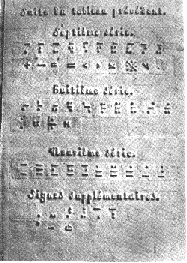(To be used only in modern music)
A. Notes with Unusual Shape
  |
| |
Black note head with no stem |
  |
| |
X-shaped note head |
  |
| |
Vertical stems that designate quasi-notes |
  |
| |
Diamond or triangle-shaped note head |
  |
| |
End of a slanting line to designate approximate pitch (quasi-note) |
|
| |
When no specific note value appears, the value of an 8th note is
used, i.e.,    |
B. Tone Clusters
 
 |
| |
Tone cluster with natural sign |
 
 |
| |
Tone cluster with flat sign |
 
 |
| |
Tone cluster with sharp sign |
 
 |
| |
Tone cluster with no accidentals specified |
|
 
 
 
 
 i.e., play evey note in this octave as a chord i.e., play evey note in this octave as a chord |
C. "Fan-shaped" Rhythmic Groups
 
 
  |
| |
Accelerando within rhythmic group |
 
 
  |
| |
Ritardando within rhythmic group |
 
 
  |
| |
Steady rhythm |
  |
| |
End of Rhythmic group as shown in print |
|
|

